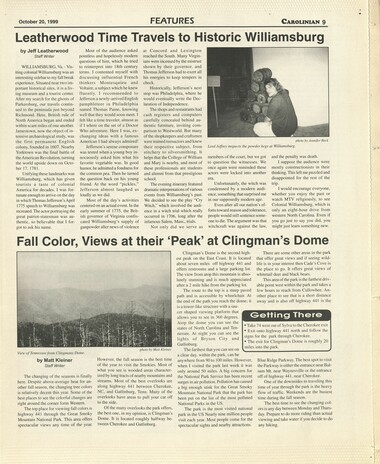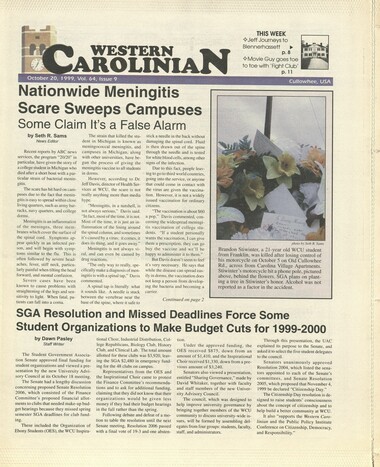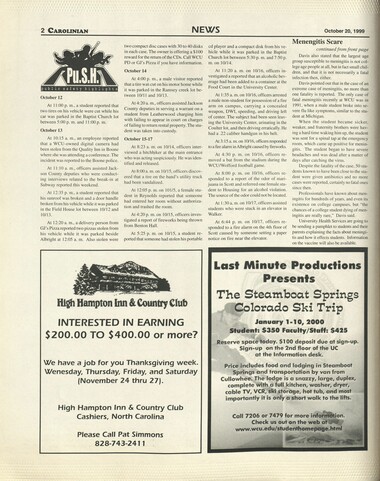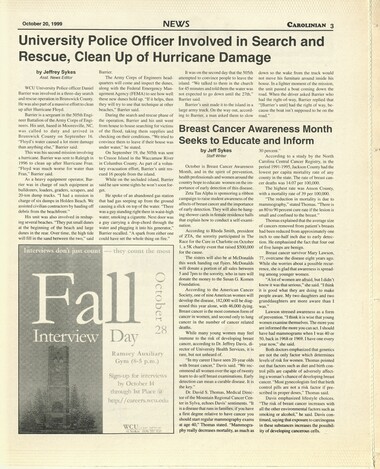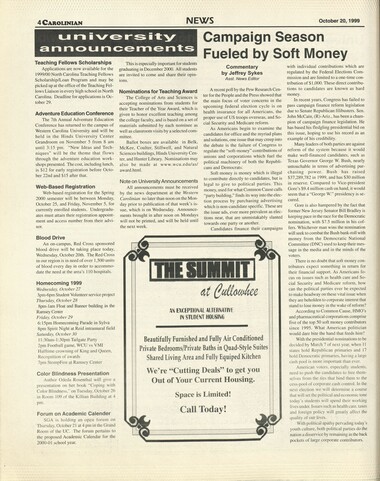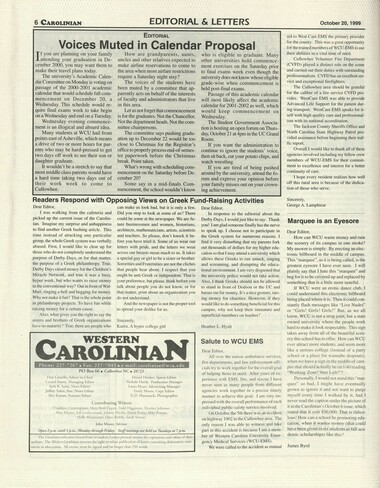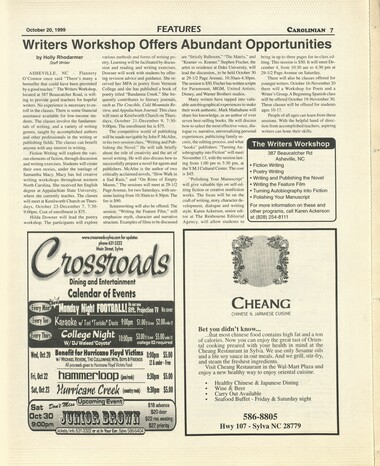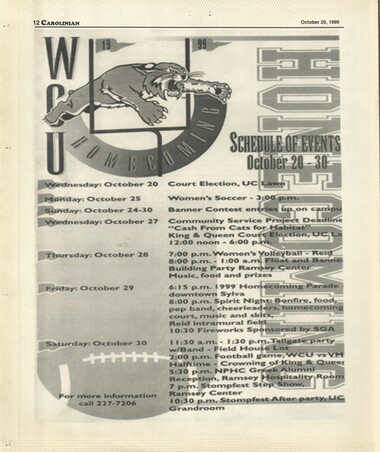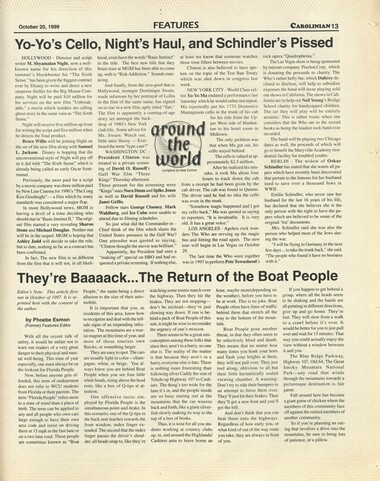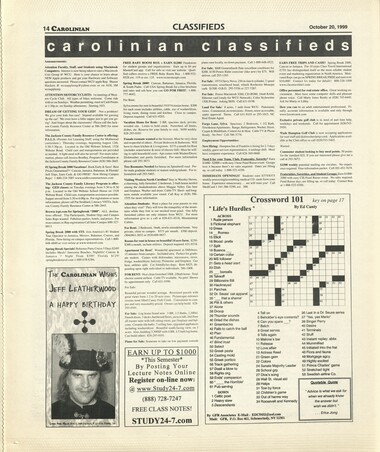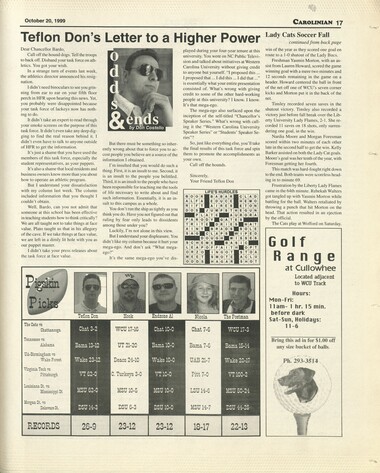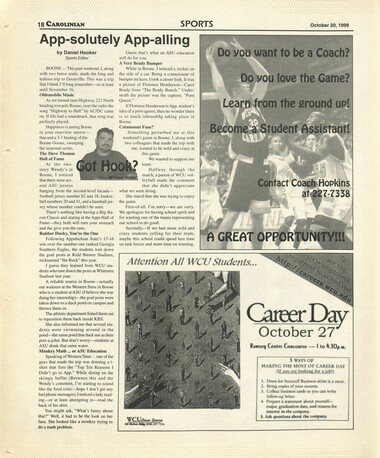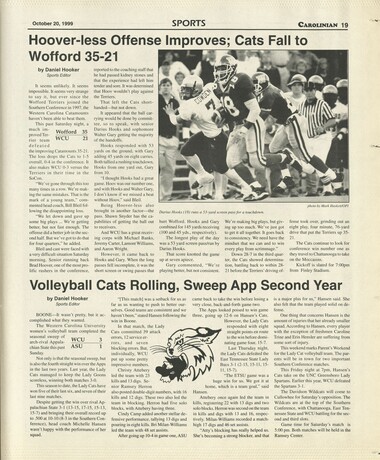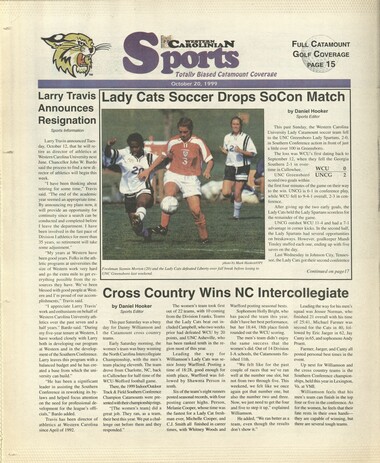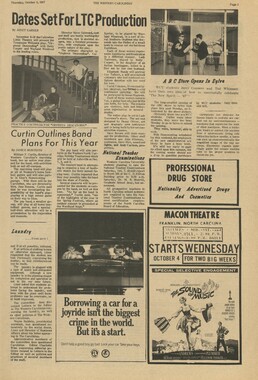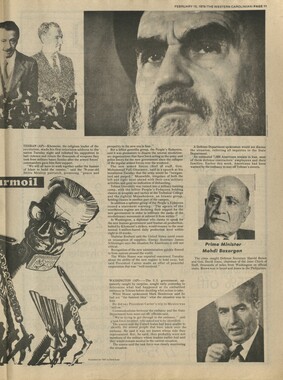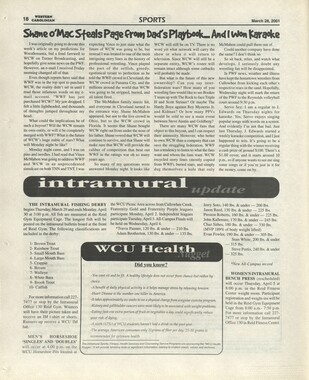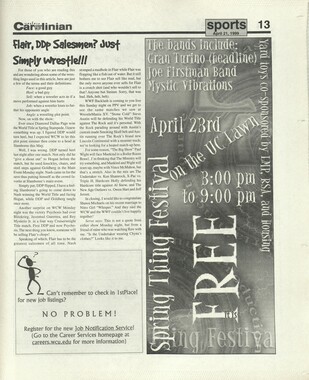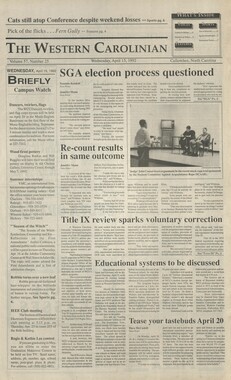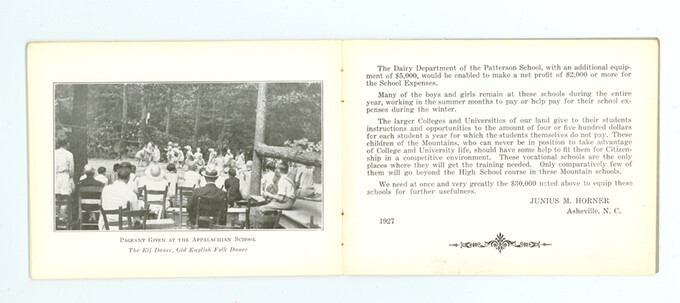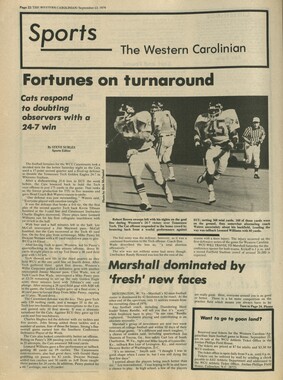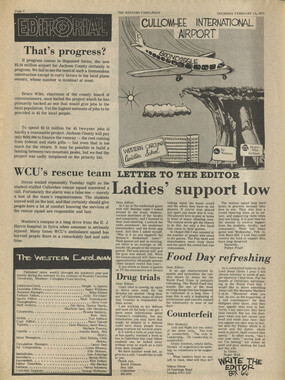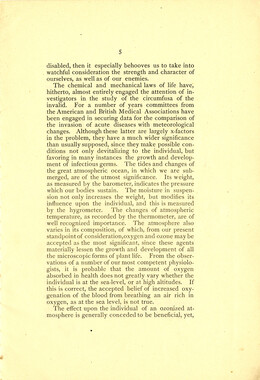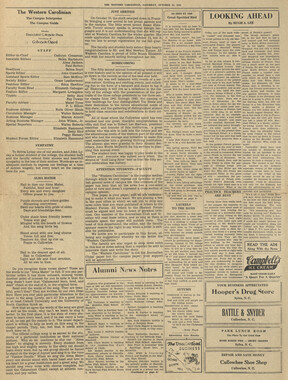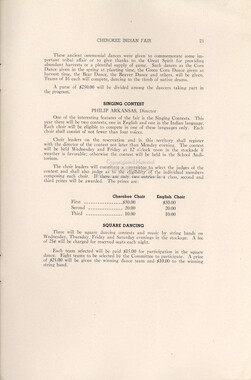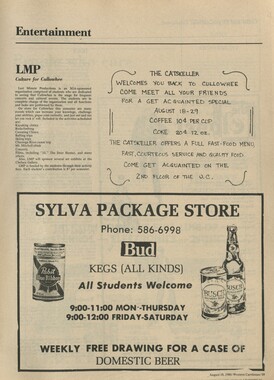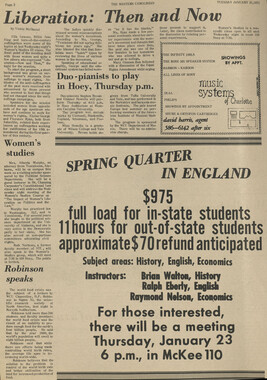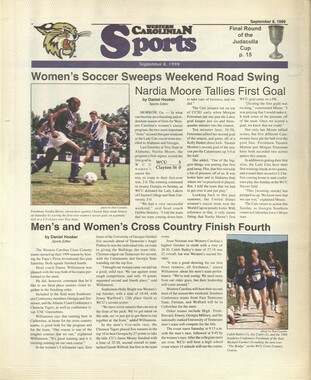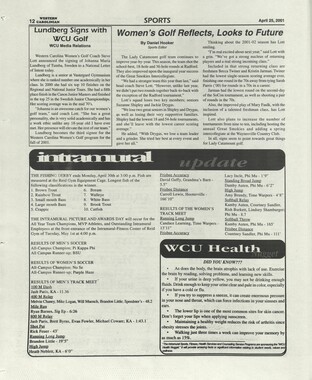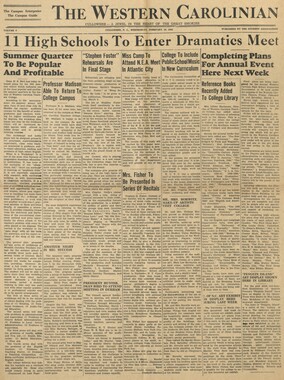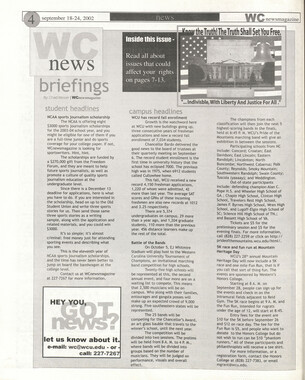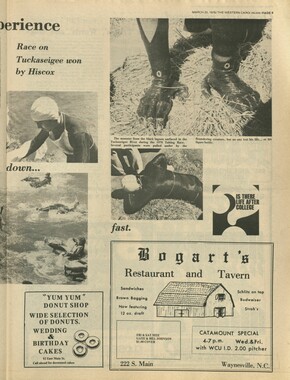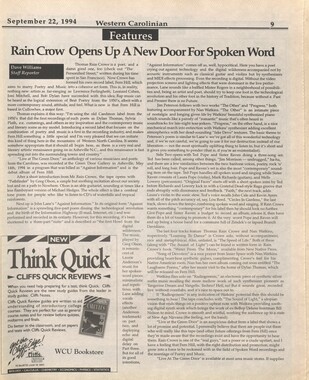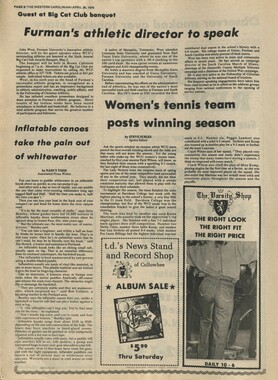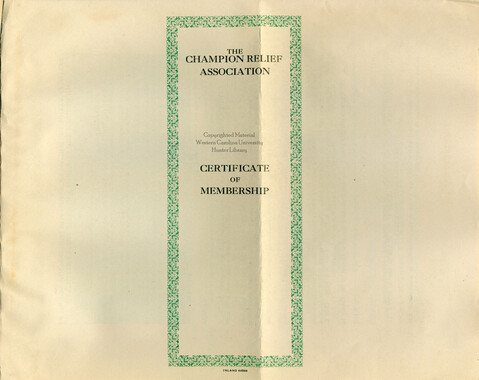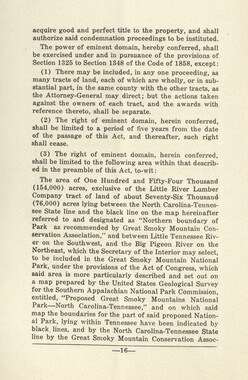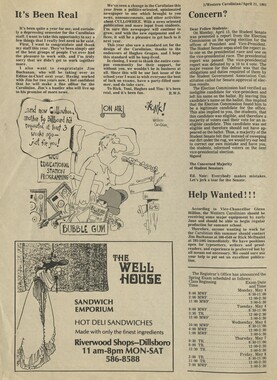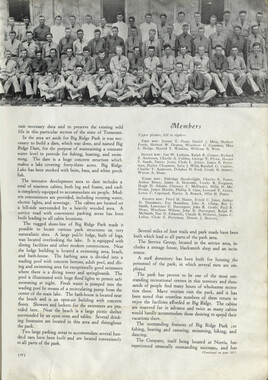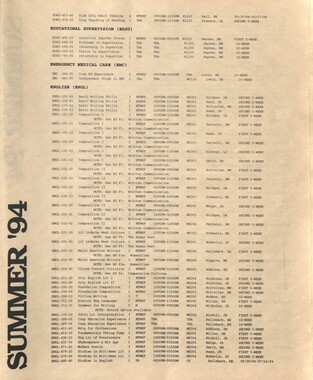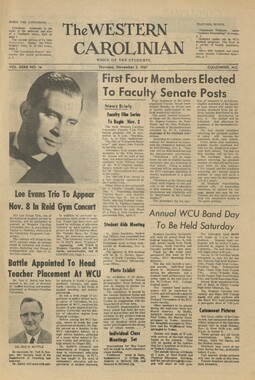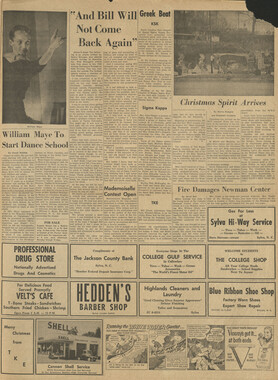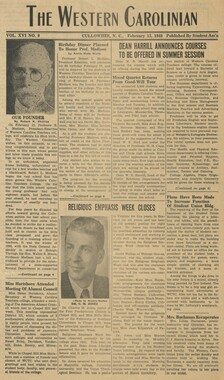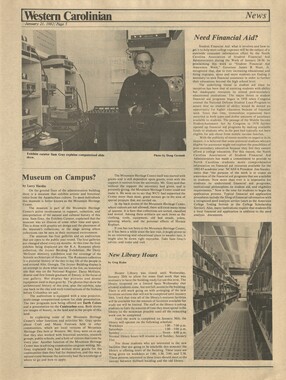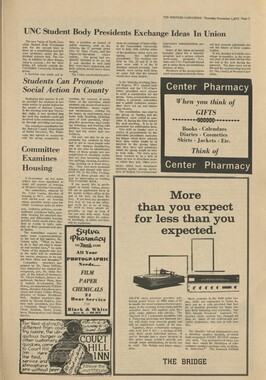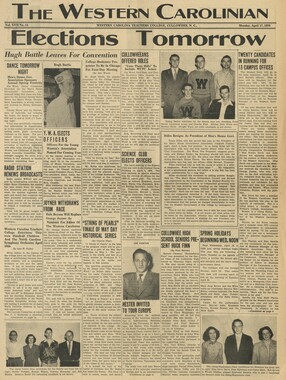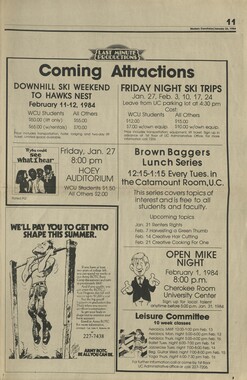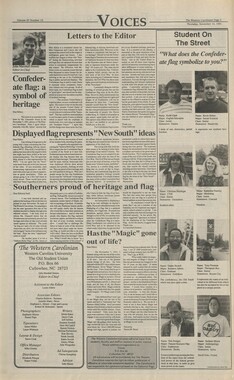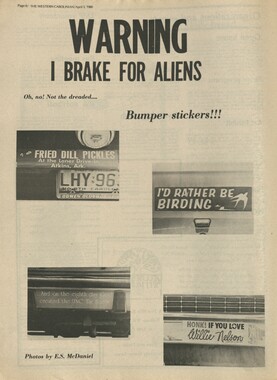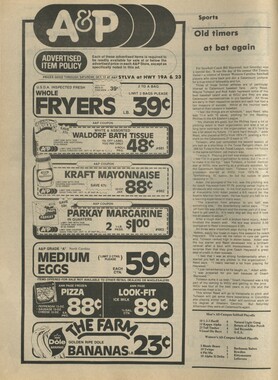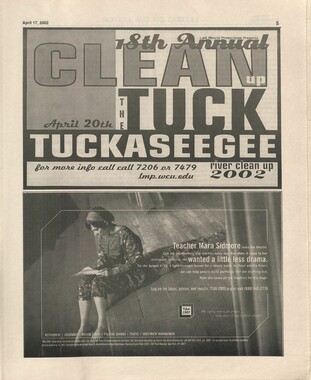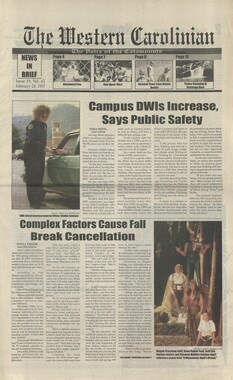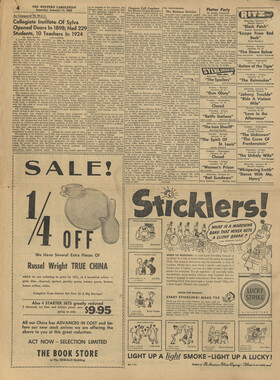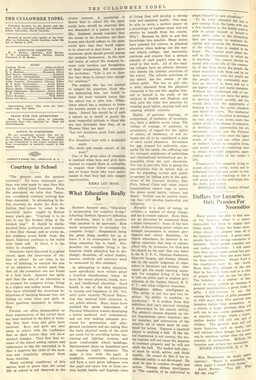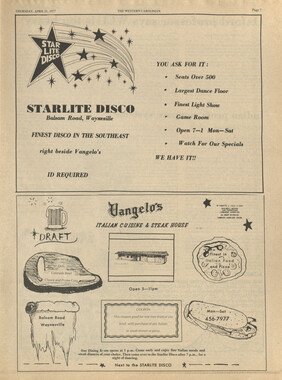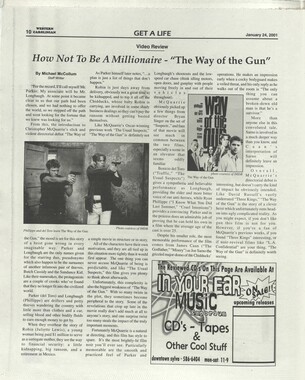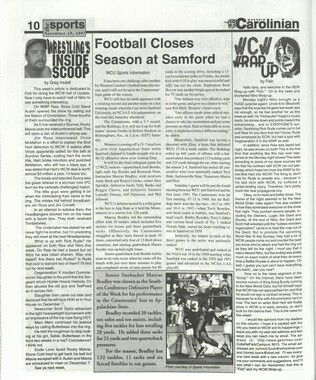Western Carolina University (20)
View all
- Canton Champion Fibre Company (2308)
- Cherokee Traditions (293)
- Civil War in Southern Appalachia (165)
- Craft Revival (1942)
- Great Smoky Mountains - A Park for America (2767)
- Highlights from Western Carolina University (430)
- Horace Kephart (941)
- Journeys Through Jackson (154)
- LGBTQIA+ Archive of Jackson County (26)
- Oral Histories of Western North Carolina (314)
- Picturing Appalachia (6772)
- Stories of Mountain Folk (413)
- Travel Western North Carolina (160)
- Western Carolina University Fine Art Museum Vitreograph Collection (129)
- Western Carolina University Herbarium (92)
- Western Carolina University: Making Memories (708)
- Western Carolina University Publications (2283)
- Western Carolina University Restricted Electronic Theses and Dissertations (146)
- Western North Carolina Regional Maps (71)
- World War II in Southern Appalachia (131)
University of North Carolina Asheville (6)
View all
- Allanstand Cottage Industries (62)
- Appalachian National Park Association (53)
- Bennett, Kelly, 1890-1974 (1388)
- Berry, Walter (76)
- Brasstown Carvers (40)
- Carver, George Washington, 1864?-1943 (26)
- Cathey, Joseph, 1803-1874 (1)
- Champion Fibre Company (233)
- Champion Paper and Fibre Company (297)
- Cherokee Indian Fair Association (16)
- Cherokee Language Program (22)
- Crowe, Amanda (40)
- Edmonston, Thomas Benton, 1842-1907 (7)
- Ensley, A. L. (Abraham Lincoln), 1865-1948 (275)
- Fromer, Irving Rhodes, 1913-1994 (70)
- George Butz (BFS 1907) (46)
- Goodrich, Frances Louisa (120)
- Grant, George Alexander, 1891-1964 (96)
- Heard, Marian Gladys (60)
- Kephart, Calvin, 1883-1969 (15)
- Kephart, Horace, 1862-1931 (313)
- Kephart, Laura, 1862-1954 (39)
- Laney, Gideon Thomas, 1889-1976 (439)
- Masa, George, 1881-1933 (61)
- McElhinney, William Julian, 1896-1953 (44)
- Niggli, Josephina, 1910-1983 (10)
- North Carolina Park Commission (105)
- Osborne, Kezia Stradley (9)
- Owens, Samuel Robert, 1918-1995 (11)
- Penland Weavers and Potters (36)
- Roberts, Vivienne (15)
- Roth, Albert, 1890-1974 (142)
- Schenck, Carl Alwin, 1868-1955 (1)
- Sherrill's Photography Studio (2565)
- Southern Highland Handicraft Guild (127)
- Southern Highlanders, Inc. (71)
- Stalcup, Jesse Bryson (46)
- Stearns, I. K. (213)
- Thompson, James Edward, 1880-1976 (226)
- United States. Indian Arts and Crafts Board (130)
- USFS (683)
- Vance, Zebulon Baird, 1830-1894 (1)
- Weaver, Zebulon, 1872-1948 (58)
- Western Carolina College (230)
- Western Carolina Teachers College (282)
- Western Carolina University (1794)
- Western Carolina University. Mountain Heritage Center (18)
- Whitman, Walt, 1819-1892 (10)
- Wilburn, Hiram Coleman, 1880-1967 (73)
- Williams, Isadora (3)
- Cain, Doreyl Ammons (0)
- Crittenden, Lorraine (0)
- Rhodes, Judy (0)
- Smith, Edward Clark (0)
- Appalachian Region, Southern (2399)
- Asheville (N.C.) (1917)
- Avery County (N.C.) (26)
- Blount County (Tenn.) (161)
- Buncombe County (N.C.) (1671)
- Cherokee County (N.C.) (283)
- Clay County (N.C.) (555)
- Graham County (N.C.) (233)
- Great Smoky Mountains National Park (N.C. and Tenn.) (510)
- Haywood County (N.C.) (3522)
- Henderson County (N.C.) (70)
- Jackson County (N.C.) (4692)
- Knox County (Tenn.) (25)
- Knoxville (Tenn.) (12)
- Lake Santeetlah (N.C.) (10)
- Macon County (N.C.) (420)
- Madison County (N.C.) (211)
- McDowell County (N.C.) (39)
- Mitchell County (N.C.) (132)
- Polk County (N.C.) (35)
- Qualla Boundary (981)
- Rutherford County (N.C.) (76)
- Swain County (N.C.) (2113)
- Transylvania County (N.C.) (247)
- Watauga County (N.C.) (12)
- Waynesville (N.C.) (73)
- Yancey County (N.C.) (72)
- Aerial Photographs (3)
- Aerial Views (60)
- Albums (books) (4)
- Articles (1)
- Artifacts (object Genre) (228)
- Bibliographies (1)
- Biography (general Genre) (2)
- Cards (information Artifacts) (38)
- Clippings (information Artifacts) (191)
- Crafts (art Genres) (622)
- Depictions (visual Works) (21)
- Design Drawings (1)
- Drawings (visual Works) (184)
- Envelopes (73)
- Facsimiles (reproductions) (1)
- Fiction (general Genre) (4)
- Financial Records (12)
- Fliers (printed Matter) (67)
- Glass Plate Negatives (381)
- Guidebooks (2)
- Internegatives (10)
- Interviews (812)
- Land Surveys (102)
- Letters (correspondence) (1013)
- Manuscripts (documents) (619)
- Maps (documents) (177)
- Memorandums (25)
- Minutes (administrative Records) (59)
- Negatives (photographs) (5835)
- Newsletters (1285)
- Newspapers (2)
- Occupation Currency (1)
- Paintings (visual Works) (1)
- Pen And Ink Drawings (1)
- Periodicals (193)
- Personal Narratives (10)
- Photographs (12976)
- Plans (maps) (1)
- Poetry (7)
- Portraits (1960)
- Postcards (329)
- Programs (documents) (151)
- Publications (documents) (2237)
- Questionnaires (65)
- Scrapbooks (282)
- Sheet Music (2)
- Slides (photographs) (402)
- Songs (musical Compositions) (2)
- Sound Recordings (796)
- Specimens (92)
- Speeches (documents) (15)
- Tintypes (photographs) (8)
- Transcripts (322)
- Video Recordings (physical Artifacts) (23)
- Vitreographs (129)
- Text Messages (0)
- A.L. Ensley Collection (275)
- Appalachian Industrial School Records (7)
- Appalachian National Park Association Records (336)
- Axley-Meroney Collection (2)
- Bayard Wootten Photograph Collection (20)
- Bethel Rural Community Organization Collection (7)
- Blumer Collection (5)
- C.W. Slagle Collection (20)
- Canton Area Historical Museum (2110)
- Carlos C. Campbell Collection (282)
- Cataloochee History Project (65)
- Cherokee Studies Collection (4)
- Daisy Dame Photograph Album (5)
- Daniel Boone VI Collection (1)
- Doris Ulmann Photograph Collection (112)
- Elizabeth H. Lasley Collection (1)
- Elizabeth Woolworth Szold Fleharty Collection (4)
- Frank Fry Collection (95)
- George Masa Collection (173)
- Gideon Laney Collection (452)
- Hazel Scarborough Collection (2)
- Hiram C. Wilburn Papers (28)
- Historic Photographs Collection (236)
- Horace Kephart Collection (861)
- Humbard Collection (33)
- Hunter and Weaver Families Collection (1)
- I. D. Blumenthal Collection (4)
- Isadora Williams Collection (4)
- Jesse Bryson Stalcup Collection (47)
- Jim Thompson Collection (224)
- John B. Battle Collection (7)
- John C. Campbell Folk School Records (80)
- John Parris Collection (6)
- Judaculla Rock project (2)
- Kelly Bennett Collection (1407)
- Love Family Papers (11)
- Major Wiley Parris Civil War Letters (3)
- Map Collection (12)
- McFee-Misemer Civil War Letters (34)
- Mountain Heritage Center Collection (4)
- Norburn - Robertson - Thomson Families Collection (44)
- Pauline Hood Collection (7)
- Pre-Guild Collection (2)
- Qualla Arts and Crafts Mutual Collection (12)
- R.A. Romanes Collection (681)
- Rosser H. Taylor Collection (1)
- Samuel Robert Owens Collection (94)
- Sara Madison Collection (144)
- Sherrill Studio Photo Collection (2558)
- Smoky Mountains Hiking Club Collection (616)
- Stories of Mountain Folk - Radio Programs (374)
- The Reporter, Western Carolina University (510)
- Venoy and Elizabeth Reed Collection (16)
- WCU Gender and Sexuality Oral History Project (32)
- WCU Mountain Heritage Center Oral Histories (25)
- WCU Oral History Collection - Mountain People, Mountain Lives (71)
- WCU Students Newspapers Collection (1744)
- Western North Carolina Tomorrow Black Oral History Project (69)
- William Williams Stringfield Collection (2)
- Zebulon Weaver Collection (109)
- African Americans (390)
- Appalachian Trail (35)
- Artisans (521)
- Cherokee art (84)
- Cherokee artists -- North Carolina (10)
- Cherokee language (21)
- Cherokee pottery (101)
- Cherokee women (208)
- Church buildings (167)
- Civilian Conservation Corps (U.S.) (110)
- College student newspapers and periodicals (1830)
- Dams (103)
- Dance (1023)
- Education (222)
- Floods (61)
- Folk music (1015)
- Forced removal, 1813-1903 (2)
- Forest conservation (220)
- Forests and forestry (1058)
- Gender nonconformity (4)
- Great Smoky Mountains National Park (N.C. and Tenn.) (181)
- Hunting (38)
- Landscape photography (10)
- Logging (103)
- Maps (84)
- Mines and mineral resources (8)
- North Carolina -- Maps (18)
- Paper industry (38)
- Postcards (255)
- Pottery (135)
- Railroad trains (71)
- Rural electrification -- North Carolina, Western (3)
- School integration -- Southern States (2)
- Segregation -- North Carolina, Western (5)
- Slavery (5)
- Sports (452)
- Storytelling (245)
- Waterfalls -- Great Smoky Mountains (N.C. and Tenn.) (66)
- Weaving -- Appalachian Region, Southern (280)
- Wood-carving -- Appalachian Region, Southern (328)
- World War, 1939-1945 (173)
Western Carolinian Volume 64 (65) Number 09
Item
Item’s are ‘child’ level descriptions to ‘parent’ objects, (e.g. one page of a whole book).
-
-
October 20,1999 FEATURES Carolinian 9 Leatherwood Time Travels to Historic Williamsburg by Jeff Leatherwood Staff Writer WILLIAMSBURG, Va. - Visiting colonial Williamsburg was an interesting sidebar to my fall break experience. Situated near two important historical sites, it is a living museum and a tourist center. After my search for the ghosts of Parkersburg, our travels continued to the peninsula just beyond Richmond. Here, British rule of North America began and ended within scant miles of one another. Jamestown, now the object of intensive archaeological study, was the first permanent English colony, founded in 1607. Nearby Yorktown was the final battle of the American Revolution, turning the world upside down on October 17, 1781. Unifying these landmarks was Williamsburg, which has given tourists a taste of colonial America for decades. I was fortunate enough to arrive on the day in which Thomas Jefferson's April 1775 speech to Williamsburg was recreated. The actor portraying the great patriot-statesman was authentic, so believable that I forgot to ask his name. Most of the audience asked pointless and hopelessly modern questions of him, which he tried to reinterpret into 18th century terms. I contented myself with discussing influential French thinkers Montesquieu and Voltaire, a subject which he knew fluently. I recommended to Jefferson a newly-arrived English pamphleteer in Philadelphia named Thomas Paine, knowing well that they would soon meet. I felt like a time traveler, almost as if I where on the set of a Doctor Who adventure. Here I was, exchanging ideas with a famous American I had always admired! Jefferson's serene composure was tested when a young boy innocuously asked him what his favorite vegetable was. In good humor, he admitted a fondness for the common pea. Then he turned the question back on his young friend. At the word "pickles," Jefferson almost laughed as loudly as we did. Most of the day's activities centered on an actual event. In the early summer of 1775, the British governor of Virginia confiscated Williamsburg's supply of gunpowder after news of violence at Concord and Lexington reached the South. Many Virginians were incensed by the mistrust shown by their governor, and Thomas Jefferson had to exert all his energies to keep tempers in check. Historically, Jefferson's next stop was Philadelphia, where he would eventually write the Declaration of Independence. The shops and restaurants had cash registers and computers carefully concealed behind authentic furniture, inviting comparison to Westworld. But many of the shopkeepers and craftsmen were trained reenactors and knew their respective subject, from stitchery to silversmithing. It helps that the College of William and Mary is nearby, and most of these professionals are students and alumni from that prestigious school. The evening itinerary featured dramatic interpretations of various events from Williamsburg's past. We decided to see the play "Cry Witch," which involved the audience in a witch trial which really occurred in 1706, long after the infamous Salem, Mass., trials. Not only did we serve as photo by Jennifer Beck Lord Jeffrey inspects the powder kegs at Williamsburg. members of the court, but we got to question the witnesses. We once again were reminded these actors were locked into another era. Unfortunately, the witch was condemned by a modern audience, something that surprised me in our supposedly modern age. Even after all our nation's efforts toward reason and tolerance, people would still sentence someone to die. The argument was that witchcraft was against the law, and the penalty was death. I suppose the audience were mostly constructionists in their thinking. This left me puzzled and disappointed for the rest of the trip. I would encourage everyone, whether you enjoy the past or watch MTV religiously, to see Colonial Williamsburg, which is only an eight-hour drive from western North Carolina. Even if you go just to say you did, you might just learn something new. Fall Color, Views at their 'Peak' at Clingman's Dome View of Tennessee from Clingmans Dome. by Matt Kleiner Staff Writer The changing of the seasons is finally here. Despite above-average heat for another fall season, the changing tree colors is relatively decent this year. Some of the best places to see the colorful changes are right around the corner form Western. The top place for viewing fall colors is highway 441 through the Great Smoky Mountain National Park. This area offers spectacular views any time of the year. photo by Matt Kleiner However, the fall season is the best time of the year to visit the Smokies. Most of what you see is wooded areas characterized by long tracts of nearby mountains and streams. Most of the best overlooks are along highway 441 between Cherokee, NC, and Gatlinburg, Tenn. Many of the overlooks have areas to pull your car off to the side. Of the many overlooks the park offers, the best one, in my opinion, is Clingman's Dome. It is located roughly halfway between Cherokee and Gatlinburg. Clingman's Dome is the second highest peak on the East Coast. It is located about seven miles off highway 441 and offers restrooms and a large parking lot. The view from atop this mountain is absolutely stunning and is much appreciated after a 2 mile hike from the parking lot. The route to the top is a steep paved path and is accessible by wheelchair. At the end of the path you reach the dome; it is a tower-like structure with a saucer shaped viewing platform that allows you to see in 360 degrees. Atop the dome you can see the states of North Carolina and Tennessee. At night you can see the lights of Bryson City and Gatlinburg. The farthest that you can see on a clear day, within the park, can be anywhere from 90 to 100 miles. However, when I visited the park last week it was only around 50 miles. A big concern for the National Park Service has been recent surges in air pollution. Pollution has caused a big enough stink for the Great Smoky Mountain National Park that the park has been put on the list of the most polluted National Parks in the US. The park is the most visited national park in the US Nearly nine million people visit each year. Most people come for the spectacular sights and nearby attractions. There are some other areas in the park that offer great views and if seeing wildlife is in your interest then Cade's Cove is the place to go. It offers great views of whitetail deer and black bears. This area of the park is the farthest driv- able point west within the park and takes a few hours to reach from Cullowhee. Another place to see that is a short distance away and is also off highway 441 is the Getting There • Take 74 west out of Sylva to the Cherokee exit • Exit onto highway 441 north and follow the signs for the park through Cherokee. • The exit for Clingman's Dome is roughly 20 miles into the park. Blue Ridge Parkway. The best spot to visit the Parkway is either the entrance near Balsam Mt. near Waynesville or the entrance off of highway 441, near Cherokee. One of the downsides to traveling this time of year through the park is the heavy flow of traffic. Weekends are the busiest time during the fall season. The best time to see the changing colors is any day between Monday and Thursday. Prepare to do more riding than actual viewing and take water if you decide to do any hiking.
Object
Object’s are ‘parent’ level descriptions to ‘children’ items, (e.g. a book with pages).
-
The Western Carolinian is Western Carolina University's student-run newspaper. The paper was published as the Cullowhee Yodel from 1924 to 1931 before changing its name to The Western Carolinian in 1933.
-
